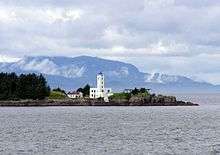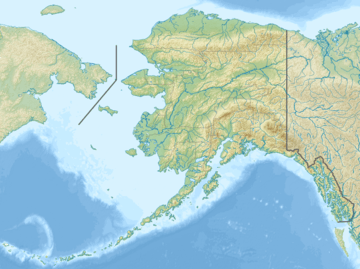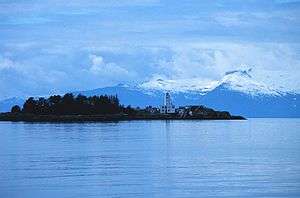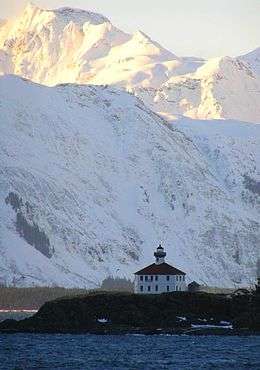Five Finger Islands Light
 Five Finger Islands Light in 2003 | |
 Alaska | |
| Location |
The Five Finger southernmost island Frederick Sound Alaska United States |
|---|---|
| Coordinates | 57°16′13″N 133°37′54″W / 57.27038°N 133.63154°WCoordinates: 57°16′13″N 133°37′54″W / 57.27038°N 133.63154°W |
| Year first constructed | 1902 (first) |
| Year first lit | 1935 (current) |
| Automated | 1984 |
| Foundation | concrete pier |
| Construction | reinforced concrete tower |
| Tower shape | square tower with lantern centered on the roof of keeper's house |
| Markings / pattern |
art deco architecture white tower, black lantern |
| Height | 68 feet (21 m) |
| Focal height | 81 feet (25 m) |
| Original lens | Fourth order Fresnel lens |
| Range | 18 nautical miles (33 km; 21 mi) |
| Characteristic |
Fl W 10s. emergency light Fl W 6s of reduced intensity when main light is extinguished |
| Admiralty number | G6342 |
| ARLHS number | ALK-007 |
| USCG number | 6-23280 |
| Managing agent | |
|
Five Finger Light Station | |
|
Alaska Heritage Resources Survey
| |
| Nearest city | Petersburg, Alaska |
| Area | less than one acre |
| Architect | U.S. Lighthouse Service; U.S. Lighthouse Board |
| Architectural style | Modern Movement, Art Deco |
| MPS | Light Stations of the United States MPS |
| NRHP reference # | 04000416[3] |
| AHRS # | SUM-00009 |
| Added to NRHP | May 12, 2004 |
| Heritage |
place listed on the National Register of Historic Places |
The Five Finger Islands Light is a lighthouse located on a small island that lies between Stephens Passage and Frederick Sound in southeastern Alaska. It and Sentinel Island Light Station were the first U.S. government lighthouses opened in Alaska, lit first on March 21, 1902.[4]
It became the last lighthouse in Alaska to be automated on August 14, 1984.
History
In 1901, a contract of $22,500 was awarded to construct a lighthouse on the southernmost of the Five Finger Islands. Completed in 1902, it was a rectangular lighthouse with a square tower, elevated several feet above the surrounding hipped roof. Atop the tower sat a lantern room from which a fourth-order Fresnel lens produced a fixed beam of white light at a focal plane of 68 feet (21 m). The original structure burned down in December 1933. The tower was rebuilt using public works appropriations. The current structure is made of concrete, which was completed and relit in 1935. It was automated by the United States Coast Guard in 1984.
It was listed on the National Register of Historic Places as Five Finger Light Station in 2004. The listing was as a historic district including four contributing buildings and one other contributing structure.[3]
The original lighthouse burned. The replacement, built in 1935, "is a good example of Modern Movement architecture, popular in the 1930s for concrete buildings, and adapted by the U.S. Lighthouse Service as the agency replaced the original wood frame lighthouse buildings at many of its sixteen staffed stations in Alaska."[4]
The light station was listed on the National Register of Historic Places in 2004.[3]
Gallery
- Original 1902 Lighthouse – USCG archive photo
 1992
1992
See also
References
- ↑ Five Finger Islands The Lighthouse Directory. University of North Carolina at Chapel Hill. Retrieved 7 June 2016
- ↑ Alaska Historic Light Station Information & Photography United States Coast Guard. Retrieved 7 June 2016
- 1 2 3 National Park Service (2010-07-09). "National Register Information System". National Register of Historic Places. National Park Service.
- 1 2 Valerie O'Hare and Jennifer Klein (March 23, 2004). "National Register of Historic Places Registration: Five Finger Light Station / Five Finger Lighthouse / AHRS Site No. SUM-00009". National Park Service. and accompanying photos
External links
- United States Coast Guard
- 2007 U.S. postage stamp featuring Five Finger Islands Light
- "Historic Light Station Information and Photography: Alaska". United States Coast Guard Historian's Office.
- Lighthouse Friends — Five Finger Islands Lighthouse
- Rowlett, Russ. "Lighthouses of Alaska". The Lighthouse Directory. University of North Carolina at Chapel Hill.
| Wikimedia Commons has media related to Five Fingers Light. |


.svg.png)